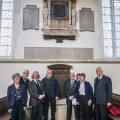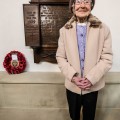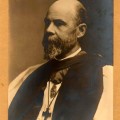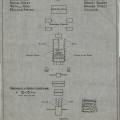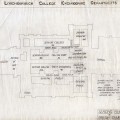Parish Church Service of Re-dedication for Loughborough War Memorials
24 April 2015
- Representatives of the Charnwood Great War Project team who worked to re-site the memorials at All Saints with Holy Trinity Church in Loughborough.
- Hilda Onions was just 7 years old when her brother, William Godber, was killed in 1917. Now aged 104. Hilda remembers William as a cheerful lad who made a big fuss of her when he came home on leave.
The afternoon of Sunday 19th April 2015 saw a service of re-dedication in Loughborough to mark the re-positioning of the All Saints and Holy Trinity War Memorials.
Over the past few months, a team of conservators has been busy re-positioning two memorials at All Saints’ Church, Loughborough. At the same time, a group of researchers has been investigating the stories behind those named on the memorials, and discovering what it was like to live in Loughborough during the years 1914-1918.
The two memorials, that of All Saints Church itself and that of Holy Trinity, which was nearby but is now closed down, were badly positioned and could not be seen. The Charnwood Great War Centenary Project applied successfully for money from the Heritage Lottery Fund to display these memorials in a place where they could once more be appreciated.
The service was led by the Reverend Tony Edmonds, Area Dean. As in the original service of dedication on April 23rd 1923, representatives of the British Legion, of the armed services, of Loughborough Grammar School, which has close ties with the church, and of the University (then Loughborough College under the leadership of Herbert Schofield, an All Saints parishioner) were all present.
The names of the fallen of both parishes were read out, as well as short biographical details discovered by Janet Grant and her research team.
- John Chapman, who attended Loughborough Grammar School and worked for the Brush, was a “considerate and cheerful officer who was shot between the eyes whilst reconnoitering the enemy’s position using field glasses”.
- John William Taylor (the third) of the Loughborough bell founding family, worked for his father at the foundry and became well known as a bell ringer. He was educated at Shaftesbury Grammar School and Nottingham University, where he obtained a BSc. He emigrated to Canada where he spent a number of years as a ‘teamster’ or truck driver. When war broke out he enlisted as a Private in the 66thBattalion, Canadian Regiment and was killed at about midnight on the 15th or 16th September 1916. His brother, Arnold Bradley Taylor, had already died in July of the same year.
- Canon Thomas Pitts, Rector of All Saints from 1885 to 1918, lost his son Francis, and the Rector of Holy Trinity, David Dewar, lost both his sons, David and Lancelot.
- William Godber was the eldest boy in a family of eight children. He worked at the Maypole Dairy in Loughborough Market place and lived in Thomas Street, very near to Holy Trinity church. He enlisted in the 5thLeicestershire regiment and was a stretcher bearer. On April 8th 1917 he wrote to his fiancé, Maud, “I have had enough and want to come home.” A few days later on the 17th April 1917 he was killed by a sniper’s bullet aged just 17.
A guest of honor at the re-dedication service was Hilda Onions, William Godber’s youngest sister, now aged 104. Hilda was just 7 years old when William died. She remembers ‘Billie’ as a very cheerful lad who used to make a big fuss of her when he came home on leave.
The Reverend Stephen Cherry, rector of All Saints from 1994-2006, also attended the re-dedication service and explained why the memorials had been moved.
Everyone stood while the names of the fallen of both parishes were read out.
Wreaths were laid near the memorials by the Mayor, Councillor Paul Day, on behalf of the Parish, and by David Hobday from the British Legion on behalf of the Armed Services. In 1923 at the original unveiling a Union Jack was unfurled, the National Anthem was sung, and a muffled bell tolled.
A prayer was said by a member of the Council of Faiths, representing the many different faiths groups that have come to Loughborough since the First and Second World Wars and whose members also suffered in those conflicts.
A member of the British Legion recited the Kohima epitaph:
“We pledge ourselves anew to our work in support of wartime generations and to all those in other conflicts since.”
The Great War was supposed to be ‘the war to end all wars’. In 1923 when the original memorial was dedicated, there was a feeling of bitterness that the loss of life had been in vain, as mentioned by the Archbishop of Sheffield in his sermon.
By the 1960’s many war memorials were neglected, hidden away like the All Saints’ memorial, or even disposed of. This re-dedication service shows how, without wanting in any way to promote or glorify war, we value the memorials and remember the dead.
We can be satisfied that the wishes of Major General Stuart Wortley, spoken in 1923 from the chancel steps, have been fulfilled.
“When their day is passed, and the present generation who have experienced the Great War have passed away, [this] will serve as a reminder of these things.”
It was a very moving service.
Janet Grant for Charnwood Great War Centenary Project
The First College Sunday and the First Student Rag: 1920
14 April 2015
- Dean Ryle, Westminster 1920
- Rag procession chart for the visit of the Minister of Labour Dr Macnamara in 1920
- College Sunday seating plan
With the end of the First World War and – in 1919 – the introduction of Loughborough College’s new diploma courses, Principal Herbert Schofield was determined that the College should develop along the lines of a university. One sign of this was the decision to allow students to wear undergraduate gowns at lectures. Another was the introduction of an annual service at the parish church with a sermon by a distinguished visiting preacher.
This was known as ‘College Sunday’ when staff and students in academic dress, preceded by the newly acquired College Mace, left the College in Greenclose Lane and were joined by the Mayor and Corporation to walk in procession to and from the parish church. The first College Sunday was held on 7th November 1920 when, according to the Loughborough Monitor, 400-500 students assembled. College Sunday subsequently took place on the third Sunday morning in October each year to mark the start of the College year.
Schofield succeeded in getting many eminent clerics to preach at the annual College Sunday service. The very first speaker was the Dean of Westminster, the Right Reverend HE Ryle. Only a few months earlier, in August 1920, Dean Ryle had received a suggestion from an army chaplain that an unknown British soldier from the battlefields of France should be buried in Westminster Abbey to represent the thousands of Empire dead.
Thanks to Dean Ryle the proposal was adopted. Indeed, on the evening of the 7th November 1920, the very day that the Dean had preached at Loughborough’s first ever College Sunday service, the body of the Unknown Soldier was brought home from France. He was buried in Westminster Abbey a few days later on Remembrance Day, 11th November 1920. The famous inscription on the stone commemorating him was written by Dean Ryle himself.
After his College Sunday sermon at Loughborough the Dean requested a day’s holiday for the students, which Principal Schofield agreed to. Dean Ryle also addressed the College in the Congregational Chapel the following day. Significantly, his lecture was on ‘The Making of a University’. Accompanied by a great crowd of students and the Cadet Corps Band, the Dean was then conveyed on a car drawn by ropes to the Great Central Station to catch the 12.32 pm train.
When Dean Ryle had been waved off, Principal Schofield, the Rector, Canon Briggs, and James Driver, the College Works Manager, were hauled back to College in a station barrow. This impromptu student Rag was Loughborough’s first ever Rag – ‘a mild one’, commented the Loughborough Monitor, ‘by comparison with what is promised when opportunity for more elaborate organisation and preparation is given’!
College Sunday continued up until 1962. The tradition of a procession followed by a church service was re-enacted in October 2009 as part of the University’s Centenary celebrations. Archive photographs and film footage of past College Sunday events, along with the more recent re-enactment of 2009, can all be found on the Loughborough University website.
Rag is alive and well and Loughborough’s students now raise over a million pounds a year for charity.
Jenny Clark, Loughborough University Archives
